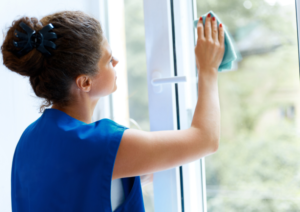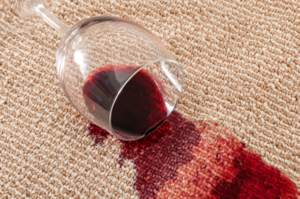Creating a cleaning schedule can keep all of the equipment and surfaces in your facility looking like new. From glass LED screens on computers, tablets, phones, and other electronics, to steel handles and appliances, to the vinyl on your fitness equipment — all of these surfaces need to be cleaned and disinfected.
To keep your place of business spotless, safe, and looking great year-round, we recommend creating a Cleaning Plan for every area of your facility. A solid facility cleaning strategy can make the job easier and protect customers and employees from getting sick.

WHY IS CLEANLINESS IMPORTANT?
Cleaning is important for the overall success of your business. It plays a big role in how customers view your brand and if they will do repeat business with you. It keeps employees healthier. And it reflects the pride you take in your business.
ISSA has demonstrated that cleaning has real and measurable value. In their Value of Clean study they found:
- 97% of guests would avoid a business in the future if they encountered a dirty washroom
- 86% of guests rate cleanliness as the most important factor when choosing a restaurant, hotel, cafe, or bar
- Sick employees cost businesses $16.6 billion per year in paid sick days
Maintaining a noticeably clean business also pays in ways you might not realize. When you neglect to regularly clean items like keyboards or treadmills, they can become full of debris and result in malfunction. When this happens, the machine may need to be replaced, reducing its overall life span and costing you money.
Keeping your facility clean leaves a positive impression on anyone who visits. People will respect the hard work you do to make them comfortable and satisfied.

3 WAYS CREATING A CLEANING SCHEDULE CAN HELP
Ensures all surfaces, equipment, and areas get cleaned consistently
Developing a cleaning schedule ensures everything get cleaned consistently. It gives you a clear and measurable way to share expectations and instructions with your employees or your cleaning crew. A cleaning schedule sets your entire organization up for success because it’s a plan that details exactly how to keep surfaces clean and free of germs.
Simplifies the process and makes it easier for team members and crews
Developing a cleaning schedule makes it easier for everyone involved to complete cleaning tasks. Instead of trying to guess or figure out what was cleaned and when, you have a resource that organizes and documents this important information.
By assigning tasks and responsibilities, it becomes clear and easy to understand who is responsible for what. A cleaning schedule keeps you organized and “in the know” so you can quickly understand what’s happening in your facility.
Creates structure
Processes and protocols are important to help set up best practices for health and safety. A cleaning schedule can help clarify what cleaning products to use and what not to use. For example, some cleaners may be unsafe if mixed together. A documented cleaning plan avoids mistakes like this and provides the safest procedures for those cleaning.
A documented plan can also include what cleaning tools to use. You may not want an untrained employee to clean a delicate surface like a treadmill touchscreen or a marble sink with an abrasive cleaner that could cause erosion or damage.

CREATE A CLEANING PLAN
It can be intimidating to get started but creating a cleaning schedule will be worth it. Here’s a starter guide:
1. OUTLINE THE CLEANING TASKS THAT NEED TO BE COMPLETED
What are all of the cleaning tasks that need to be completed? List out everything that should be cleaned in your facility, from high-touch areas that will require daily attention, to more maintenance-like tasks that can be done once or twice a year. You can also break this down by room or area, such as conference rooms, kitchens, break rooms, restrooms, etc.
2. DETERMINE CLEANING FREQUENCY BASED ON TRAFFIC, FACILITY TYPE, AND/OR THE AREA YOU’RE FOCUSED ON
How often do you need to clean? Based on your facility type or the area, you may need to clean, sanitize or disinfect more or less often. Here are some examples:
- 100+ people per day may require you to clean several times a week while <100 may require fewer cleanings
- Healthcare settings often require daily cleaning and disinfection since these environments are subject to many germs
- Fitness centers require daily cleaning and disinfection because of the bodily fluids (think sweat) that get tossed around
- Food prep areas require cleaning and even sanitizing/disinfecting after each use
- Bathrooms require daily cleaning disinfection because of bodily fluids and their high traffic

3. DETERMINE WHEN TO CLEAN
Set standards for when you will be cleaning. Will you clean after a layer of dust is visible? Will you disinfect as soon as blood has come into contact with a surface (the answer is YES). And what day will cleaning occur?
Consider if the task needs to happen:
- Daily
- Weekly
- Situationally – after blood, vomit or bodily fluids come into contact with a surface
- When someone spills something
- After a layer of dust is visible
- After someone visibly sick has visited the facility or touched something
- On a schedule according to manufacturer instructions
4. DETERMINE WHAT PRODUCTS TO USE
Determine what cleaning products you will use for each area and each task. Will you use wipes or liquid cleaners and cloths or towels? What specific product will be used for the cleaning task? The following products are common:
- Ready-to-use disinfectant wipes
- Liquids or powder cleaners and their mixing tools and containers, if needed
- Towels and cloths
- Personal Protective Equipment (PPE) for various cleaners – gloves, goggles, face masks, etc.
Determine when they will be used and in what manner they will be used:
- To kill bacteria, viruses, and fungi that can cause sickness and infection
- To remove dust
- To disinfect after contact with bodily fluids
- To remove oil or grease
- To condition or polish wood
- To preserve the life and functionality of equipment
5. ASSIGN TASKS AND DETERMINE WHO WILL BE CLEANING
Delegating cleaning responsibilities to your staff should be included in your cleaning plan. Who will do what? Consider:
- Assigning tasks to appropriate personnel on your staff or to your cleaning crew
- Hiring a cleaning agency
- Determining who will be responsible for completing specific cleaning tasks
- Clearly communicate cleaning responsibilities to all parties and create forms or a system for tracking

PLANNING FOR CLEANLINESS = SUCCESS
If you run a business or facility, you want to find ways to make your job easier, to keep people safe, and to keep your space tidy and appealing to your staff and your visitors. The cleanliness of your building is a priority. Unclear expectations, not having a plan or system, and not understanding how or how often to clean can stop the best-intended manager from taking action and keeping their facility in pristine condition.
The good news is that there is a way to easily see consistent results in the form of a clean, safe, and appealing space. Use the step-by-step guide above to create yours today and start reaping the reward of happier customers and happier employees.
